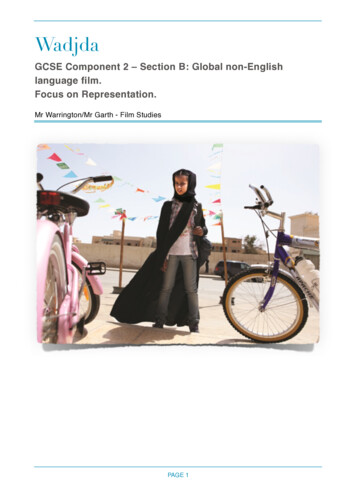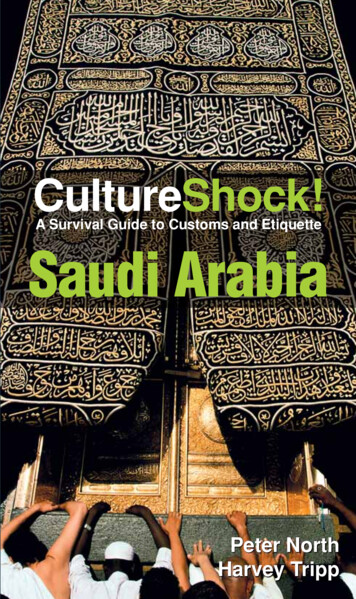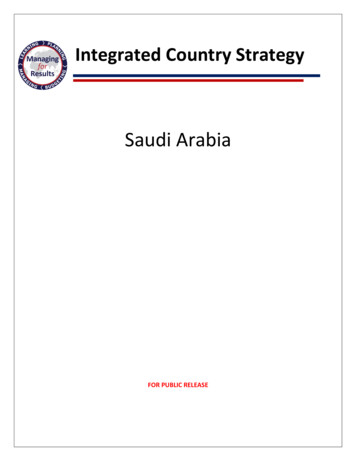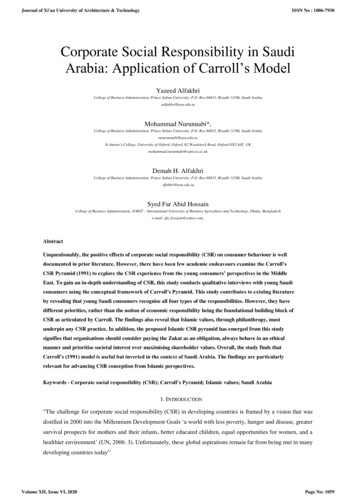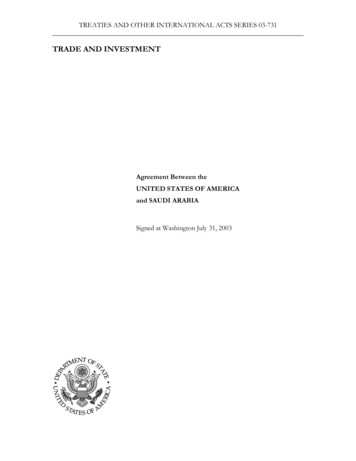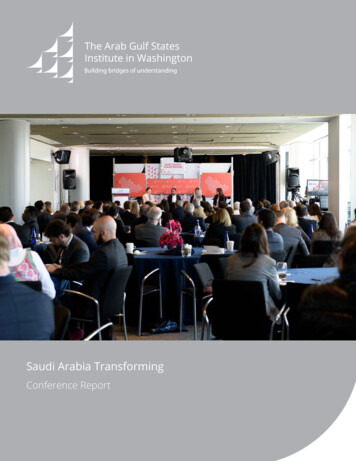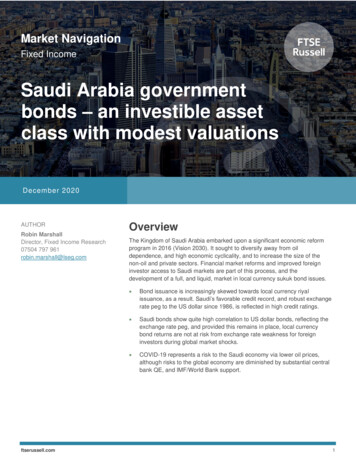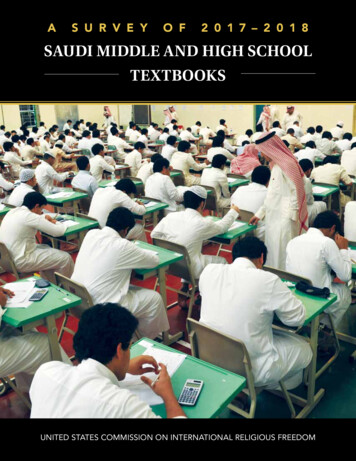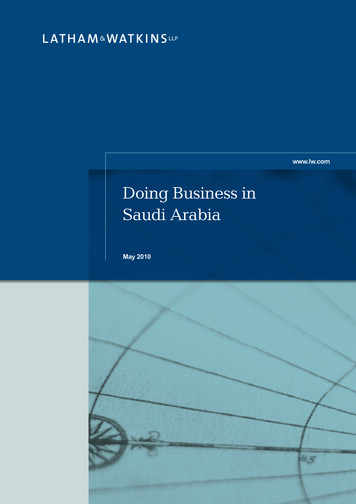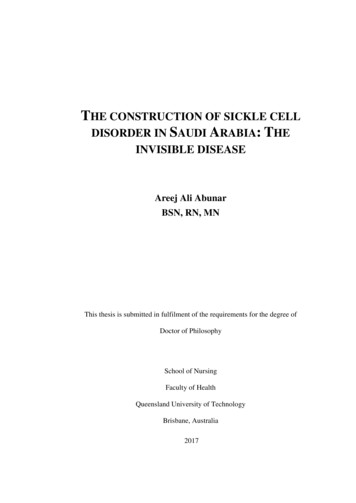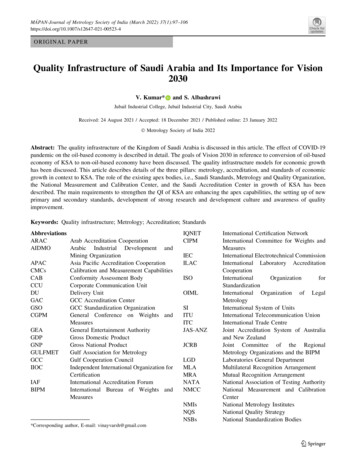
Transcription
MAPAN-Journalof Metrology Society of India (March 2022) 0523-4ORIGINAL PAPERQuality Infrastructure of Saudi Arabia and Its Importance for Vision2030V. Kumar*and S. AlbashrawiJubail Industrial College, Jubail Industrial City, Saudi ArabiaReceived: 24 August 2021 / Accepted: 18 December 2021 / Published online: 23 January 2022 Metrology Society of India 2022Abstract: The quality infrastructure of the Kingdom of Saudi Arabia is discussed in this article. The effect of COVID-19pandemic on the oil-based economy is described in detail. The goals of Vision 2030 in reference to conversion of oil-basedeconomy of KSA to non-oil-based economy have been discussed. The quality infrastructure models for economic growthhas been discussed. This article describes details of the three pillars: metrology, accreditation, and standards of economicgrowth in context to KSA. The role of the existing apex bodies, i.e., Saudi Standards, Metrology and Quality Organization,the National Measurement and Calibration Center, and the Saudi Accreditation Center in growth of KSA has beendescribed. The main requirements to strengthen the QI of KSA are enhancing the apex capabilities, the setting up of newprimary and secondary standards, development of strong research and development culture and awareness of qualityimprovement.Keywords: Quality infrastructure; Metrology; Accreditation; StandardsAbbreviationsARACArab Accreditation CooperationAIDMOArabic Industrial Development andMining OrganizationAPACAsia Pacific Accreditation CooperationCMCsCalibration and Measurement CapabilitiesCABConformity Assessment BodyCCUCorporate Communication UnitDUDelivery UnitGACGCC Accreditation CenterGSOGCC Standardization OrganizationCGPMGeneral Conference on Weights andMeasuresGEAGeneral Entertainment AuthorityGDPGross Domestic ProductGNPGross National ProductGULFMETGulf Association for MetrologyGCCGulf Cooperation CouncilIIOCIndependent International Organization forCertificationIAFInternational Accreditation ForumBIPMInternational Bureau of Weights CRBLGDMLAMRANATANMCCNMIsNQSNSBsInternational Certification NetworkInternational Committee for Weights andMeasuresInternational Electrotechnical CommissionInternational Laboratory orStandardizationInternational Organization of LegalMetrologyInternational System of UnitsInternational Telecommunication UnionInternational Trade CentreJoint Accreditation System of Australiaand New ZealandJoint Committee of the RegionalMetrology Organizations and the BIPMLaboratories General DepartmentMultilateral Recognition ArrangementMutual Recognition ArrangementNational Association of Testing AuthorityNational Measurement and CalibrationCenterNational Metrology InstitutesNational Quality StrategyNational Standardization Bodies*Corresponding author, E-mail: vinayvarsh@gmail.com123
IUNUNIDOUNECEWBGWTOV. Kumar, S. A. BashrawiPlan Do Check/Study ActProject Management InstituteQuality InfrastructureRegional Conformity Assessment SchemeRegional Metrology OrganizationRegional Standardization OrganizationSaudi Accreditation CenterSaudi Arab Standards OrganizationSaudi Standards, Metrology and QualityOrganizationScience and TechnologyStandards and Metrology Institute forIslamic CountriesThe International Network of QualityInfrastructureUnited NationsUnited Nations International DevelopmentOrganizationUnited Nations Economic Cooperation forEuropeWorld Bank GroupWorld Trade Organization1. IntroductionThe overall growth of any nation depends upon QI. The QIof any nation is consisting of internationally recognizedmetrology, standards, accreditation, conformity assessment, and market surveillance. The QI is built on a technological pyramid to ensure traceability of the accurate andprecise measurements to the International System of Units.It is a basic empowering system for providing testing,calibration, inspection, and certification. The QI is a hiddenpower that connects the University, Research and Development Laboratories, Science and Technology Organizations, Civil Societies, Enterprises, and Government. Theeconomic growth and quality of life of any nation dependupon these units.As per the world competitiveness ranking 2021, grossdomestic product of KSA is USD 700.1 Billion having 20thrank [1] in the world. The real GDP growth for the year2020 was - 4.1% on 29 rank. The economy of KSA isalmost oil-based. The average crude oil production of KSAfrom January 2002 to May 2021, with 233 observations,was 9.423 million Barrel/Day. Before the COVID-19pandemic, the oil production of the KSA was at an all-timehigh in April 2020 (11.642 million Barrel/Day) and lowestin February 2002 (7.121 million Barrel/Day) [2].123The oil prices are very volatile; in 2012, the price of 1barrel of crude oil was nearly 120 USD; in 2016, it droppedto 40 USD; and in 2020 it was 20 USD, which badly affectsthe economy [3]. KSA possesses 266,578,000,000 barrelsof confirmed oil reserves as on 2016, 2nd rank in the worldand it is about 16.2% of the world’s total oil reserves of1,650,585,140,000 barrels. At the current oil consumptionrate, excluding unconfirmed reserves, and without netexports the KSA oil reserve will be available about up to221 years. Unfortunately, in the March 2020 almost allnations begun affected by the COVID-19 pandemic. Thishas affected the world activities of the economy andtherefore slowed down the economic growth and loss ofemployment, etc., and created a challenge to restore theeconomy. Due to this pandemic, the crude oil export ofKSA decreased to 5 million barrels/day in June 2020 incomparison with April 2020 in which it was more than 10million barrels/day [4]. Presently, KSA is in transitionmode to shift from an oil-based economy to a non-oilbased economy by 2030 (Vision 2030) to stabilize theeconomy. In the context of shifting to a non-oil-basedeconomy, 40 industrial cities were established in differentareas of KSA. The quality of KSA infrastructure is ranked37 out of 148 as per International Trade Center [5].The Vision 2030 [6] is specifically designed aroundthree ideas: a vibrant society, a thriving economy, and anambitious nation. The 1st idea, vibrant society is crucial toaccomplish the goals of Vision 2030 and a strong base foreconomic fortune. The KSA understands the value of avibrant society. Members of this society are living happilywith a decent life in a beautiful atmosphere supported by anempowering social and healthcare system. They feel gratified of their national identity and their ancient culturalheritage. In the 2nd idea, a thriving economy makeschances to grow all by developing an education systemendorsed to the market requirements and generating economic opportunities for small, medium, and large entrepreneurs. In the 3rd idea, KSA will identify encouragingeconomic sectors to investment implements, diversify theireconomy, and create job opportunities. The main goals ofVision 2030 are to lower the unemployment rate from 11.6to 7%, raise the share of non-oil exports from 16 to 50%,and elevate the KSA ranking index from the current position of 37 to be among the top five nations on theE-Government Survey.An executive opinion survey [7] was performed onvarious indicators mentioned in Fig. 1. From a list of 15indicators, respondents of this survey were asked to select 5indicators that they recognized as the important attractionfactors of their economy. The percentage of responses perthe indicator is shown in Fig. 1,It is obvious that the reliable infrastructure indicator hasthe highest percentage of response. QI plays a very crucial
Quality Infrastructure of Saudi Arabia.role for the growth of a nation. The QI is the foundation forgetting excellent and continuous development targets stated by UN to guarantee the inclusive economy improvement, well-respected life of people and also earth safety.The International Network of Quality Infrastructure—agroup of fourteen international organizations [8]—promotes the significance of QI and its efficient globalimplementation, particularly in developing nations withensured metrological traceability to SI units. These fourteen international organizations are the InternationalBureau of Weights and Measures, International Accreditation Forum, International Electrotechnical Commission,Independent International Organization for Certification,International Laboratory Accreditation Forum, International Certification Network, International Organization forStandardization, International Trade Center, InternationalTelecommunication Union, International Organization ofLegal Metrology, United Nations Economic Cooperationfor Europe, World Bank Group, World Trade ntOrganization.2. The Economic Growth and Quality InfrastructureModelsEconomic growth is not just measured by the increase inthe capacity of production of one’s economy but also99includes an improvement in the condition of life of thepeople. The economic growth can be calculated throughthe percentage variations of many indicators like GDP,Gross National Product and GDP per capita, etc. The QI isimportant to the productivity and growth of manufacturingindustries to enhance innovation, reduce economic distances, enable the international markets access, reduce costamount, and increase the revenues. QI of India and itsimportance for inclusive national growth has been studied[9].UNIDO defines [10] the QI as: ‘‘the system comprisingthe organizations (public and private) together with thepolicies, relevant legal and regulatory framework, andpractices needed to support and enhance the quality, safetyand environmental soundness of goods, services, and processes. The quality infrastructure is required for theeffective operation of domestic markets, and its international recognition is important to enable access to foreignmarkets. It is a critical element in promoting and sustainingeconomic development, as well as environmental andsocial well-being. It relies on metrology, standardization,accreditation, conformity assessment, and marketsurveillance.’’The neoclassical model (Solow–Swan) of economicgrowth is a well-known model. The growth model ofHarrod–Domar (1946) was modified by adding the increasein productivity to develop the Solow–Swan model. In thisnew model, more weight is given to the new capital thanFig. 1 Executive opinion survey of various indicators123
100the old one. This model [11] demonstrates the effect oftechnological progress, rate of population growth, andeconomic growth on the economy for a certain period. Thequadruple helix model given by Carayannis and Campbell[12] is widely used for economic improvement through theinteraction between different entities. ‘Mode 3’ (‘‘systemconsisting of ‘Innovation Networks’ and ’knowledgeClusters’ for knowledge creation, diffusion and use’’)agrees and highlights the co-existence and co-evolution ofvarious knowledge and invention concepts. The ‘triplehelix’ model [13] stresses three ‘helices’ academia/universities, industry, and state/government intermingle toeach other to create a general improvement structure.‘Quadruple helix’ model was developed by adding ‘fourthhelix’ ‘‘media-based and culture-based public’’ in the triplehelix model. The strong relations between the four helicesof this model are enabled via an unseen strong QI. The QImakes sure conformity assessment through well-recognized metrological, accreditation, and standards institutions. The QI in developed nations (e.g., USA) is wellformed and, therefore, results in their high GDP.3. Quality Infrastructure in the Kingdom of SaudiArabiaThe potency of the national QI system mostly dependsupon the overall measurable capabilities of internationalequivalence available with apex QI institutions and thepropagation mechanism of the available QI facilities to allthe stakeholders across the country. The summary ofinternational and KSA’s QI organizations is shown inFig. 2. All the components of QI have been appropriatelyestablished in the KSA results in constructing an internationally recognized QI.3.1. MetrologyA national metrology system depends on reliable andhighly accurate measurement standards. The purpose ofappropriate metrology infrastructure is to assure thevalidity of measurements, reliability of the inspection andtest results, and head to mutual international recognition. Areliable national metrology system can guarantee thereceipt of proper quantities to protect traders and consumers, general protection of the national economy, andcan contribute to eliminating the technical obstacles forsmooth global trade. It can keep the healthiness andsecurity of humanity resulted in prosperity and standard ofliving. The metrology infrastructure helps to measureenvironmental parameters and their variations and outlinetheir future effects on living beings. In a landmark decision, United Arab Emirates and Saudi Arabia, the BIPM’s123V. Kumar, S. A. Bashrawimember states voted on November 16, 2018, to revise theSI Units [14]. It was decided in the 26th meeting of theGeneral Conference on Weights and Measures in Versailles, France, that all SI units will now be defined in termsof natural physical constant (speed of light, hyperfinestructure transition frequency of the Cesium-133 atom sluminous efficacy, Planck constant, the elementary electriccharge, the Boltzmann constant, and Avogadro constant).This will guarantee the constancy of the SI units in thefuture.3.1.1. Gulf Association for MetrologyThe Gulf Cooperation Council Standardization Organization supported the establishment of a Regional MetrologyOrganization known as the Gulf Association for Metrology[15]. The GULFMET is established to bring togetherNational Metrology Institutes of the Gulf CooperationCouncil participant countries (United Arab Emirates,Kingdom of Bahrain, Kingdom of Saudi Arabia, Sultanateof Oman, State of Qatar, State of Kuwait and the Republicof Yemen) and internationally recognized by the International Committee for Weights and Measures. GULFMET isan excellent platform to help communicate, developnourishment through the exchange of knowledge andcooperation among the member States, and enrich metrological capabilities. The GULFMET is responsible forcarrying out all the required activities to fulfill therequirements of international recognition. It also contributes to the metrological infrastructure required to protect consumers, health, safety, and the environment. TheGULFMET supports building up a strong metrologicalinfrastructure to improve the quality and encourage tradeamong its member states and the other countries of theworld. It enhances cooperation with the BIPM and OIML.The CIPM granted provisional acceptance of GULFMETas an RMO in accordance with the procedures of the JointCommittee of the Regional Metrology Organizations andthe BIPM.3.1.2. Saudi Standards, Metrology and QualityOrganizationSaudi Arab Standards Organization was established in1972, and in February 2009, its name [16] was changed toSaudi Standards, Metrology, and Quality Organization.SASO’s responsibilities are to introduce and executequality initiatives to the Kingdom. The SASO is a technicalgovernment body in KSA that governs tasks related tostandards, metrology, and quality. SASO places downSaudi standards in all required fields such as goods, products and services, and measurement and establishes procedures of conformity evaluation and certification. It offers
Quality Infrastructure of Saudi Arabia.101Fig. 2 Components ofinternational QI andcorresponding QI of KSAessential quality control measures for raw materials andproducts. SASO also hosts the SAC, responsible foraccrediting laboratories and certification bodies. Moreover,SASO establishes methods of sampling, testing, and technical inspection and elevates quality management systems.The SASO functions together with the private sector,government bodies, consumer representatives, and otherstakeholders, to build the strong QI in KSA. The SASO hasworked to develop the National Quality Strategy to represent a national framework for quality and a plan for theimplementation of quality and institutional excellence inthe Kingdom. Many interconnected features characterizethis strategy and aspects that help improve performance,increase productivity and efficiency, and it is an addedvalue that is compatible and integrated with Kingdom’sVision 2030. The Saudi standards, through its branches andoffices in the Eastern and Western Region, provide theirservices in the field of examination, testing, conformity.SASO is a member of the ISO, IEC, OIML, and BIPM,which provides immediate international support andenhances standards development competencies [17]. TheKSA has a local chapter of Project Management Institute[18]. The world’s prominent agency on project management, PMI [19] enables people to convert their ideas into areality. The PMI helps organizations and individuals towork smarter and efficiently in an ever-transforming andvibrant world through education, collaboration, research,and global advocacy. The SASO follows PMI for its projects. The SASO works on the Plan Do Check/Study Act[20] model. ‘‘PDCA cycle is a continuous loop of planning,doing, checking (or studying), and acting’’. It gives an easyand efficient methodology for solving difficulties andadministering changes. In this model, improvement actionsare tested on a small scale before updating procedures andworking practices.3.1.3. SASO Initiatives in the Field of the NQSNQS is the general framework in accordance with Kingdom’s Vision 2030 and wide-ranging perception of qualityand institutional excellence in various sectors of KSA [21].The objective behind building the NQS is to raise the levelof quality of national products and services, enhance itscompetitiveness in global market, to grow all businesssectors in a rationed and precise manner, with better valueaddition, and their positive impact on GDP and GNP. TheNQS has been developed to achieve the government’sorientation toward expanding the provision of services tocitizens in all parts of the KSA, to facilitate them inobtaining the services they seek and to emphasize theirnational role. To achieving the objectives of the NQS,SASO initiated the establishing local and internationalpartnerships with associations, institutes, and scientific andprofessional research centers in the field of quality andinstitutional excellence. SASO framed Saudi standards inmany fields, e.g., construction and building materials,chemical and petroleum products, electrical and electronicproducts, mechanical and metal products, textile products,weights and measures, quality control and conformity,information and documentation, and services.To ensure the quality of the products, some initiativestaken by SASO are:123
1021-Saudi Program for product safety (Saleem) which isresponsible for the safety of the product and ensure thatthey are not defected [22].2-The national program for legal calibration (Taqees) isresponsible for unifying the legal tests of measurementsbased on the international standard [22]. Also, it is worthmentioning that SASO has approved 30,389 standard items[22] and it got membership in 293 international committees[22] since its establishment.On 16 June 2021, Austrian Standards International andthe Saudi Standards, Metrology and Quality Organizationsigned a cooperation Program in a virtual ceremony. Itsobjective: intensifying the exchange of knowledge andexperiences in the fields of Standardization to support traderelations between the two countries [23].3.1.4. Metrological Capabilities in the Kingdom of SaudiArabiaAt the end of the last century and the beginning of theinternational industrial revolution, the need for harmonizing measurement standards around the world for an agreedsystem of Units has arisen. In 1875, the Meter conventionwas signed in Paris, which was the beginning of harmonizing the international measurement standards and establishing the scientific basis of the SI. Consequently, an NMIwas decided in each country to establish its national measurement standards and harmonies with standards of theother countries’ signatories to the meter convention. Harmonization of the measurement standards covers the realizations of the 7 basic units and the 22 derived units. SASOhas Mass, Density, Force, Volume, Hardness, Viscosity,Pressure, Gravity, Torque, Time and Frequency, acoustic,RF and Microwave, Vibration, Voltage, Power and energy,Impedance, Electromagnetic, Contact Temperature,Humidity, Thermal Radiation, Wavelength, Gauge Bock,Surface, Dimensions, Gas, Organic, Electrochemistrymeasurement laboratories. Calibration Support and QualityDepartment of SASO links NMCC and the customers. [24]3.1.5. National Measurement and Calibration CenterIn KSA, the NMCC was established in 1406 AH (1986AD). The main responsibilities of NMCC [25] are maintaining and developing the national measurement standards, calibrating the measuring instruments and standards,researching in metrology, and participating in key andsupplementary comparison programs regionally and internationally. It provides contributions to serve the scientific,legal, and industrial metrology in the governmental andprivate sectors. It also ensures metrological traceability ofthe measurement results to the SI units. The NMCC isstructured in 8 departments and includes 30 specialized123V. Kumar, S. A. Bashrawinational laboratories serving scientific, legal, and industrialmetrology in the governmental and private sectors. Theorganization chart of NMCC is shown in Fig. 3.NMCC is equipped with advanced measurement standards and calibration systems on the primary and secondary levels. In addition, NMCC provides technicalconsultations in establishing and developing calibrationlaboratories, designing and functioning calibration systemsin cooperation with industrial companies. These consultations are served to accredited laboratories and industrialbodies upon their request to enhance their productionefficiency and improve their competitiveness in the international markets. Also, NMCC contributes to environmental protection, health, and safety and provides trainingservices. The training aims to enhance the level of thetechnical staff in industry and services sectors to performaccurate calibration, testing and to prepare calibrationcertificates and test reports following the requirements ofISO/IEC 17025 including correct figures of uncertainty inmeasurement results.The NMCC participated in 12 International comparisons. Detail is shown in Fig. 43.1.6. Laboratories General DepartmentLaboratories General Department of SASO consists oflaboratories of Textile products, Construction and buildingmaterial, Electrical products, Petroleum products,Mechanical and metallic products, and chemicals. Also, itconsists of the Organization Unit of technical proficiencyTesting and Vehicles inspection unit. In some tests, Saudistandards laboratories accredited corresponding to theinternational standard (ISO 17025/2005), which providesinternational recognition for laboratories’ test results.SASO’s laboratories were established in Riyadh, and also,its branches in Makkah Al-Mukarramah and the EasternProvince. These laboratories have been leveraged withmany new latest devices and instruments in various fields[26]. The LGD conducts studies and research to developSaudi standards, reviews and provides technical commentson Saudi standard projects, gives technical consultations inthe field of testing to various departments of SASO andoutside organizations, and carrying out sample’ tests.3.2. AccreditationAccreditation is an assessment process that is designed todetermine whether a conformity assessment body is capable of performing its conformity assessment activities.The accreditation activities may include calibration, testing, inspection, or certification.
Quality Infrastructure of Saudi Arabia.103Fig. 3 The Organization chart of NMCC [25]Fig. 4 International Comparisons [25]3.2.1. GCC Accreditation Centerservices to CABs, inspection bodies, and certificationbodies in all member states. The establishment of the GAChad been founded after the study made by the Organizationof Joint Accreditation System of Australia and New Zealand which was provided by the Australian NationalAssociation of Testing Authority during the period from2005 to 2010. The GAC was able to set the documents,procedures and provide training for the experts, support tothe committees and task forces at the gulf area to work andfollow up with different projects and to review the threephases of the outputs of the technical consultations.GAC timely plans and conducts due assessments for theCABs to verify its competence, informs accredited CABsabout the modifications in the accreditation needs and givesinformation about appropriate methods to obtaintractability of measurement results. GAC publiclyannounces the current status of the accreditation granted toCABs and updates regularly in line with ISO/IEC 17011requirements.The Governments of GCC approved the establishment ofthe GCC Accreditation Center [27], to deliver reliable123
1043.2.2. GAC Recognition at the International LevelAt the international level, accreditation is monitored byILAC and the IAF. The decisions of these organizationsdetermine the nature of the accreditation offered by theGAC and its equivalent bodies in other countries. Goodparticipation of the GCC is required to be recognized bythese organizations. GAC participates in the operations ofILAC and IAF. GAC is also working at the provincial leveland is a member of both the Arab Accreditation Cooperation and the Asia Pacific Accreditation Cooperation. GACis a signatory to the ARAC Multilateral RecognitionArrangement and ARAC Mutual Recognition Arrangementrecognition agreements, which are recognized at theinternational level by ILAC and IAF. This implies that atest report or certificate accredited by GAC is also recognized by the signatories to the ILAC MRA. In this way, theGAC accreditation acts as an international passport totrade. GAC is a signatory to the Testing laboratories,Calibration Laboratories, and Inspection Bodies. [28]3.2.3. The Saudi Accreditation CenterThe SAC [29] is the national authority to provide accreditation services for conformity assessment bodies in KSA.It includes testing and calibration laboratories in all fields(e.g., electrical, construction and building materials,chemical, measurement and calibration, etc.), Inspectionbodies, Certification bodies, and Halal bodies. Participatingin the development of the national economy by raising thelevel of the technical competency of national CABs andensuring better consumer protection is the mission of SAC.In 2011, Saudi Arabia has signed the internationalaccreditation agreement by which Saudi standards wereaccredited in many fields [22]. The quality system in thelaboratories of the national center is based on the international standard requirements (ISO/IEC 17025, ISO 17034,and ISO 17043). In the period December 2019–January2020, the quality system was evaluated (Peer review) in 11field with coordination of GULFMET in which the systemwas accredited and certified as per the requirements of(ISO/IEC 17025). The SASO performed 285 accreditedtests [22].3.2.4. International Inter-comparison of SASO and BIPMThe CIPM MRA is the framework that validates theinternational equivalence of measurement standards ofNMI and their calibration and measurement certificates.The SASO participated in 44 international inter-comparisons with BIPM in different metrology areas [30]. Theinternational inter-comparisons between SASO and BIPMare mentioned in Table 1.123V. Kumar, S. A. BashrawiStandards help in numerous economic and socialactivities to improve the cost-effective distribution ofresources. Standards not only help the industry to increaseits profit at the same time assure high-quality goods andservices for users at a lower price. Therefore, the implementation of standards increases economic efficiency.Standards play an important role in the research andinnovation development with their different feedback loopsas shown in Fig. 5 [31].GCC Supreme Council established GSO, a RegionalStandardization Organization in December 2001, andstarted its operation in May 2004. Its headquarter is inRiyadh, KSA [33]. GSO operates as a single regulatorysystem to control the quality of products in the GCCmarket. The main objectives of GSO are to assist GCC toaccomplish its aims and unification of the standardizationactivities and ensure their implementation and compliance.Also, other objectives are to advance the manufacture andservice sectors, nurture the trade among GCC memberstates, protect the customer, environment, and publichealth, boost the economy of GCC participating countriesand meet the requirements of Gulf Custom Union and GulfCommon Market.GSO develops and defines GSO Standards followingspecific requirements that have been recognized byNational Standardization Bodies, businesses, and otherusers of standards. GSO standards are developed by technical teams of experts in that field/sector. The members ofthese Technical Committees are selected by the NSBs.Each NSB member in GSO is grateful to adopt each GSOStandard as a national standard and ensure its availabilityto the customers. Therefore, one GSO Standard turns out tobe the national standard in all GCC countries. Moreover, atleast 80% of adopted GSO Standards are identical toInternational Standards.3.2.5. The GSO Quality Infrastructure FrameworkThe GSO was involved in the following activity forimproving the quality infrastructure of GCC member statesTable 1 Comparison of SASO and BIPMS. No.Metrology AreaNumber1Acoustics, Ultrasound, Vibration22Electricity and Magnetism1434LengthMass and related quan
This article describes details of the three pillars: metrology, accreditation, and standards of economic growth in context to KSA. The role of the existing apex bodies, i.e., Saudi Standards, Metrology and Quality Organization, the National Measurement and Calibration Center, and the Saudi Accreditation Center in growth of KSA has been described.
